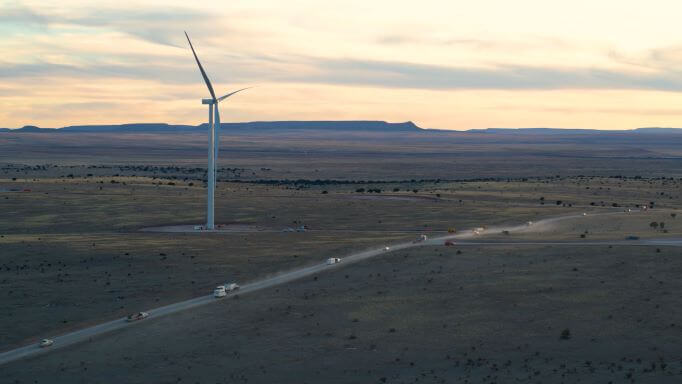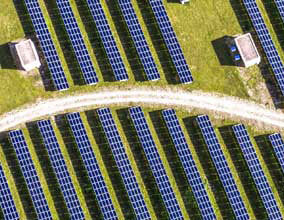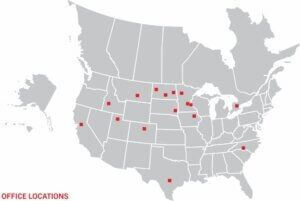Teddy Rosamond Substation Offers a Template for Future, State-of-the-Art Solar-Powered Substations

October 20, 2021
Ulteig provides CAISO services to an existing substation to meet growing need for renewable energy with addition of new solar farm
Rosemond, California — Deep in the heart of the Antelope Valley, located in the Mojave Desert, lies Rosamond, Calif., population 18,150.
While it’s a quiet community, with many of its residents employed at nearby Edwards Air Force Base, what you may not know is that Rosamond, located in Kern County, is growing a reputation as one of the nation’s leading centers for solar power.
It’s here that two ambitious solar farm projects connected to the Teddy Rosamond Substation were built on 322 acres of flat desert land in 2013 – Rosamond 1 and Rosamond 2 – which have turned Rosamond and Kern County into a hotbed of solar development. Building on this momentum, in 2020, Clearway Energy Group broke ground on an additional solar farm interconnecting to Teddy Rosamond Substation, the 192-MW Rosamond Central. This spurred the need to enhance the Teddy Rosamond Substation to service the new solar power project.
When the interconnecting Teddy Rosamond Substation was originally designed, it was built with four separate transformers that would allow capacity for future generator interconnections. Prior to 2020, the Rosamond 1 and 2 solar projects occupied two of the four transformers, but when the project changed ownership hands, Clearway saw the potential to fill the unoccupied interconnection points with a new solar development, the 192MW Rosamond Central. Rosamond Central generates enough energy for five separate off-takers or Power Purchase Agreements (PPA).
Expanding a Substation
To accommodate the addition of a third solar power project, Rosamond Central, Ulteig was contracted by Nor-Cal Controls, which was contracted to perform SCADA integration for the Teddy Rosamond Substation. Ulteig was hired specifically for its expertise in CAISO services. Ulteig’s focus was performing Independent System Operator (ISO) integration based on California ISO (CAISO) regulations – the strictest in the U.S. and a forerunner for future substation design and development in the future. Any generator that participates in the California open energy market must comply with CAISO requirements.
“As the Project Engineer for Rosamond Central, I would like to thank Ulteig for all of the support and the excellent job they did to help us get this project online,” said Jorge Narvaez, Project Engineer for Clearway. “The Ulteig team was consistent, professional, and delivered on-time to meet our milestones.”
The California ISO manages the flow of electricity across the high-voltage, long-distance power lines for the grid serving 80 percent of California and a small part of Nevada. The nonprofit public benefit corporation keeps power moving to homes and communities. As the only independent grid operator in the western U.S., the ISO grants equal access to nearly 26,000 circuit miles of transmission lines and coordinates competing and diverse energy resources into the grid where it is distributed to consumers. It also operates a competitive wholesale power market designed to promote a broad range of resources at lower prices.
As it relates specifically to solar, solar PV projects that are 1 megawatt or greater should participate in CAISO. At 500 kilowatts and above, owners can choose to participate but are not required to do so.
When a new project comes online, in this case, Rosamond Central Solar interconnecting to Teddy Rosamond Substation, ISO integration is required. Based on its previous experience with California’s ISO regulations, Ulteig’s CAISO team helped the operators through the process of the integration to synchronize systems and go commercial. As one of the few firms in the nation with expertise in California ISO integration, Ulteig provided:
Metering – Ulteig provided CAISO services for both owner meters and PPA meters (five offtakers). Unique to CAISO: Inspectors must certify meters and there are only a handful of CAISO inspectors in the U.S.
CAISO RIG integration – Ulteig installed a Remote Intelligent Gateway (RIG), a device that collects and forwards data to CAISO. A RIG is a telemetry device that allows CAISO to collect data from the project site. It’s like a data aggregator. It collects data on a local basis (e.g., generation data from the meter, protection data, meteorological station data, etc.) – concentrates it, and sends the data to CAISO. CAISO pulls this data every 4 seconds to keep track of generation in real time. Any generation facility that wants to interconnect at the transmission level must install and maintain a field RIG that meets CAISO requirements.
Consulting and management – Ulteig helped throughout the entire New Resource Implementation (NRI), which is a process specific to CAISO regulations. NRI is the process by which a resource interconnects/syncs to the CAISO grid. CAISO divides that process into six individual steps called “buckets.” At the completion of the process, the resource achieves full energization and is set up for commercial operations.
Unique Requirement: Peer-to-Peer Metering
To participate in the CAISO grid, according to Christian Arechavaleta, PMP, technical manager with Ulteig, power generation owners must use a CAISO meter, a device that measures energy coming in and out of the project site. This ongoing direct measurement allows CAISO to manage and monitor power generation in real time, ensuring the stability of the grid.
CAISO meters are different from utility or owner meters in that they are programmed and installed to the exacting standards of CAISO. The meter must be inspected and certified by a third-party ISO inspector to ensure the meter complies with CAISO standards.
A typical CAISO project only requires one meter. However, for the Rosamond substation project, the team determined a peer-to-peer metering scheme would better meet CAISO requirements. Meters need to reflect energy at the point of interconnection. However, when the energy plant (the solar farm) is built two miles away from the substation, it’s that in-between space where losses happen as electricity is being transmitted over a distance (due to Joule’s law). Multiple meters can help account for those losses.
To implement this process, 14 CAISO meters were installed within the boundaries of the Teddy Rosamond substation, which connected the Rosamond Central solar farm with the CAISO grid system at SCE’s Whirlwind 220 kV Substation. In implementing these meters, it is critical to make sure that exact MW values for each CAISO resource are accurate to two decimal places and included when creating CAISO projects.
“This project was 10 times the size of a similar project,” said Ulteig’s Arechavaleta. “However, this is going to become the norm as we see more and more solar and wind farms built in remote areas. We will see projects that need 50 and 100 meters, and with that, there is the need to ensure data integrity.”
Learn more about Ulteig’s expert CAISO services including RIG and Meter Engineering, NRI Process Management and Ancillary Services.
WHAT MAKES ULTEIG DIFFERENT?
From global energy producers to locally funded cities and private developers to government agencies, the clients we serve encompass a broad range of relationships and projects. Find out why Ulteig is a leader in the engineering industry.
Contact Us


